Charles Sturt University ACC515 Accounting and Finance Assignment
VerifiedAdded on 2022/09/18
|10
|783
|34
Homework Assignment
AI Summary
This assignment solution for ACC515 covers key concepts in accounting and finance. The document provides detailed answers to questions on nominal, real, and notional interest rates, analyzing their relationships and implications. It explores the impact of changes in cash rates on consumer behavior and the economy, along with an explanation of the Australian dividend imputation credit system. Furthermore, the assignment delves into risk assessment using beta, explaining its significance in measuring market and share price volatility. The solution includes references to support the answers and provides a comprehensive understanding of the subject matter. This resource is designed to aid students in grasping complex financial concepts and succeeding in their coursework.
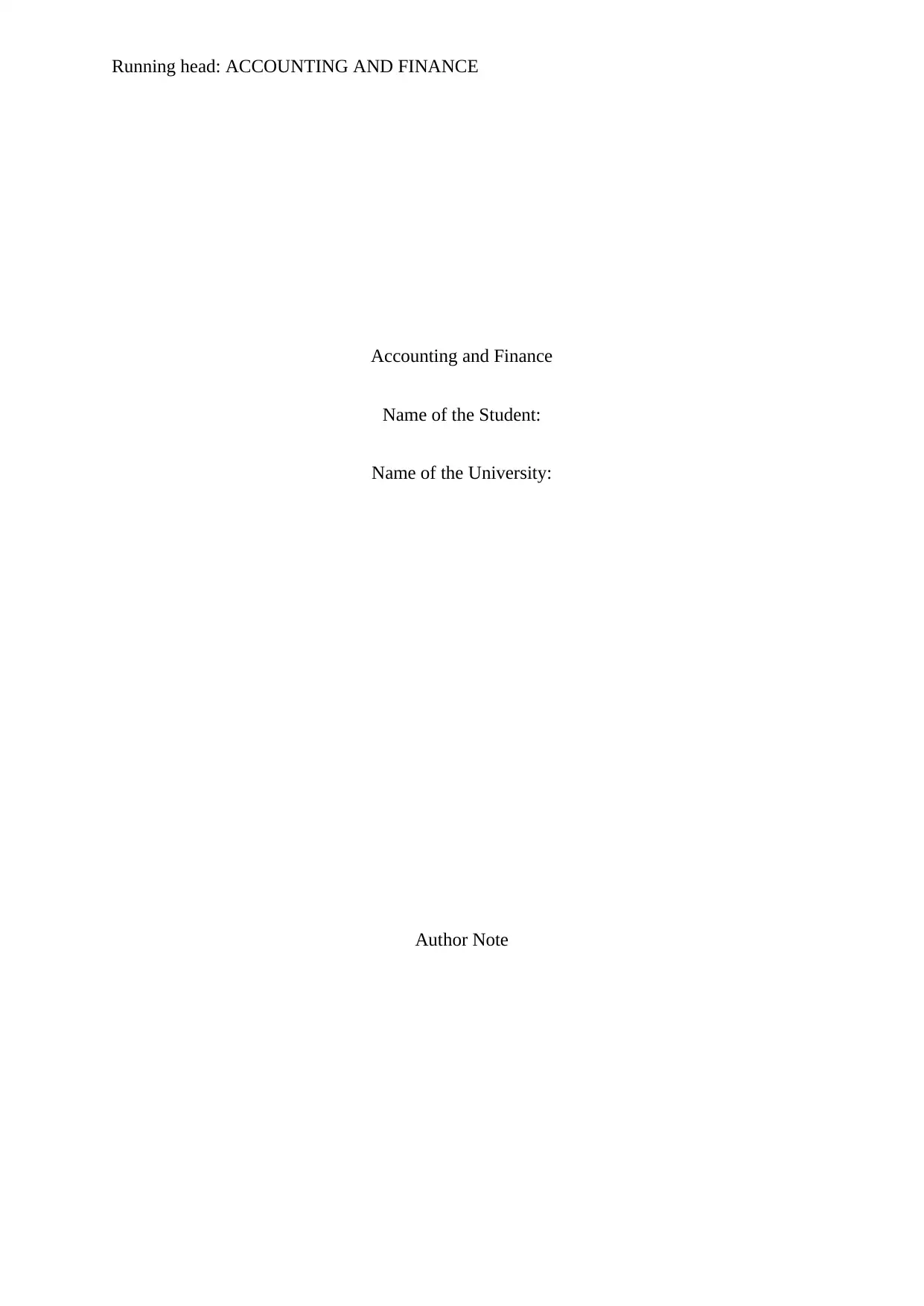
Running head: ACCOUNTING AND FINANCE
Accounting and Finance
Name of the Student:
Name of the University:
Author Note
Accounting and Finance
Name of the Student:
Name of the University:
Author Note
Paraphrase This Document
Need a fresh take? Get an instant paraphrase of this document with our AI Paraphraser
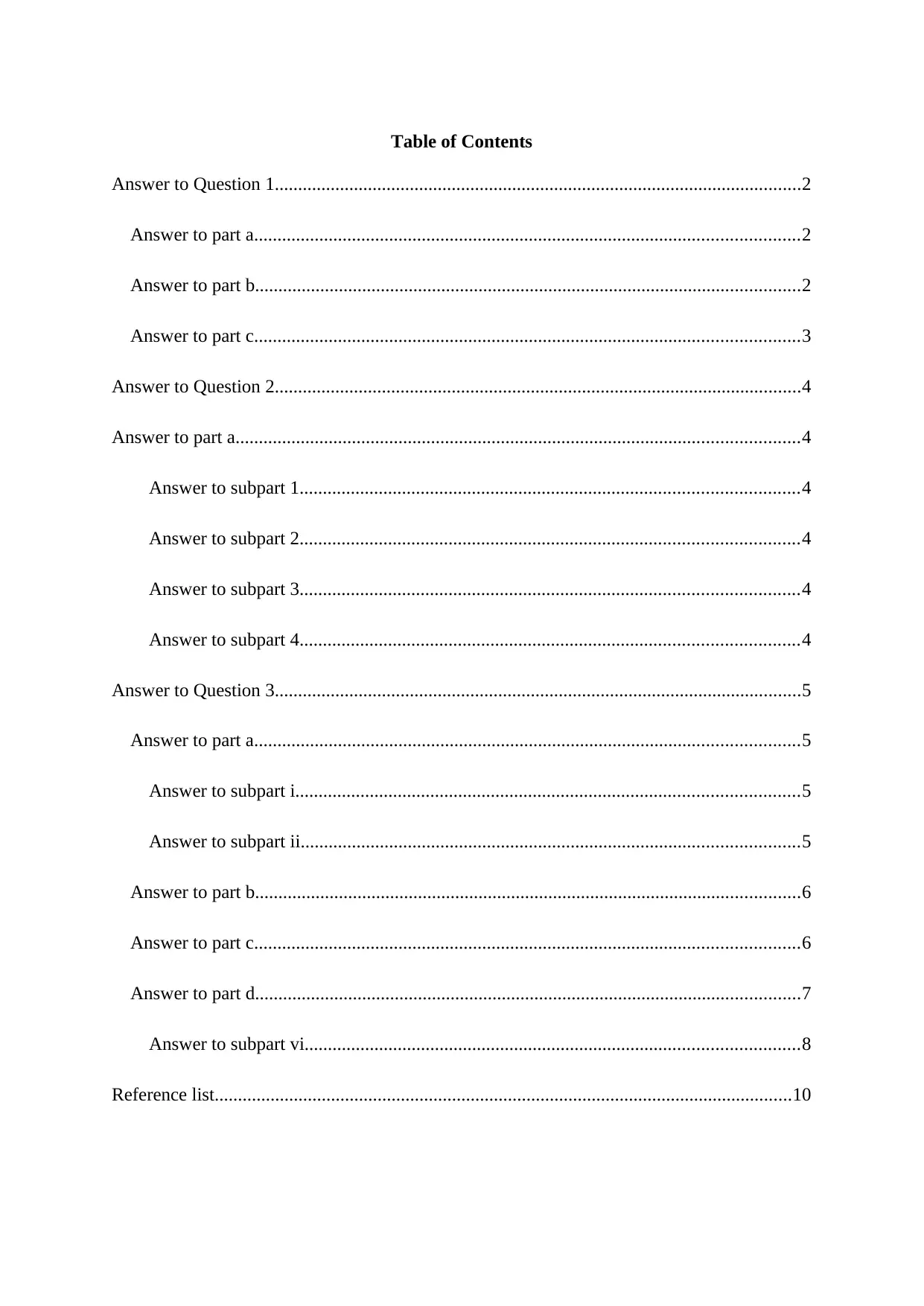
Table of Contents
Answer to Question 1.................................................................................................................2
Answer to part a.....................................................................................................................2
Answer to part b.....................................................................................................................2
Answer to part c.....................................................................................................................3
Answer to Question 2.................................................................................................................4
Answer to part a.........................................................................................................................4
Answer to subpart 1...........................................................................................................4
Answer to subpart 2...........................................................................................................4
Answer to subpart 3...........................................................................................................4
Answer to subpart 4...........................................................................................................4
Answer to Question 3.................................................................................................................5
Answer to part a.....................................................................................................................5
Answer to subpart i............................................................................................................5
Answer to subpart ii...........................................................................................................5
Answer to part b.....................................................................................................................6
Answer to part c.....................................................................................................................6
Answer to part d.....................................................................................................................7
Answer to subpart vi..........................................................................................................8
Reference list............................................................................................................................10
Answer to Question 1.................................................................................................................2
Answer to part a.....................................................................................................................2
Answer to part b.....................................................................................................................2
Answer to part c.....................................................................................................................3
Answer to Question 2.................................................................................................................4
Answer to part a.........................................................................................................................4
Answer to subpart 1...........................................................................................................4
Answer to subpart 2...........................................................................................................4
Answer to subpart 3...........................................................................................................4
Answer to subpart 4...........................................................................................................4
Answer to Question 3.................................................................................................................5
Answer to part a.....................................................................................................................5
Answer to subpart i............................................................................................................5
Answer to subpart ii...........................................................................................................5
Answer to part b.....................................................................................................................6
Answer to part c.....................................................................................................................6
Answer to part d.....................................................................................................................7
Answer to subpart vi..........................................................................................................8
Reference list............................................................................................................................10

⊘ This is a preview!⊘
Do you want full access?
Subscribe today to unlock all pages.

Trusted by 1+ million students worldwide
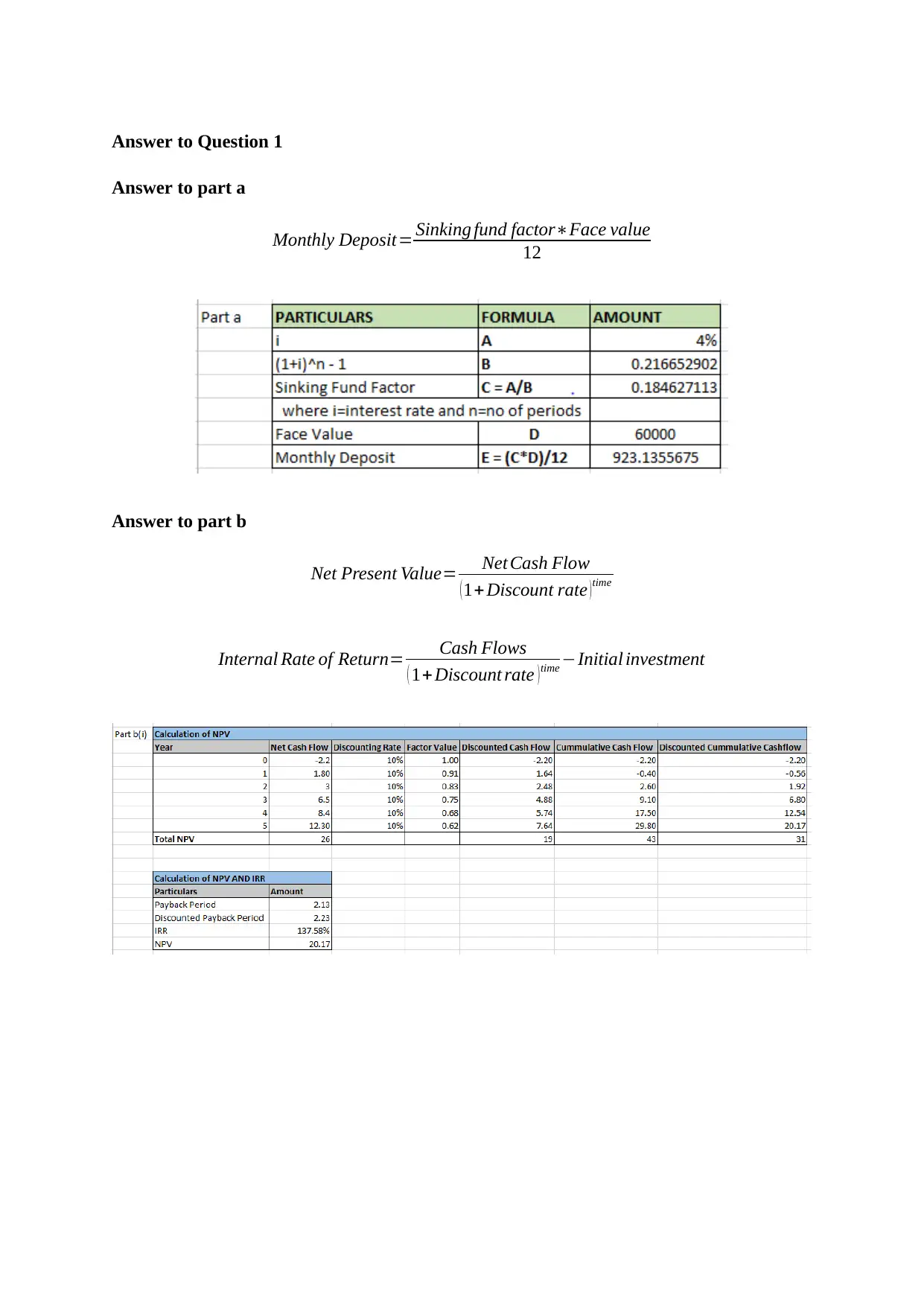
Answer to Question 1
Answer to part a
Monthly Deposit= Sinking fund factor∗Face value
12
Answer to part b
Net Present Value= Net Cash Flow
( 1+ Discount rate ) time
Internal Rate of Return= Cash Flows
( 1+ Discount rate )time −Initial investment
Answer to part a
Monthly Deposit= Sinking fund factor∗Face value
12
Answer to part b
Net Present Value= Net Cash Flow
( 1+ Discount rate ) time
Internal Rate of Return= Cash Flows
( 1+ Discount rate )time −Initial investment
Paraphrase This Document
Need a fresh take? Get an instant paraphrase of this document with our AI Paraphraser
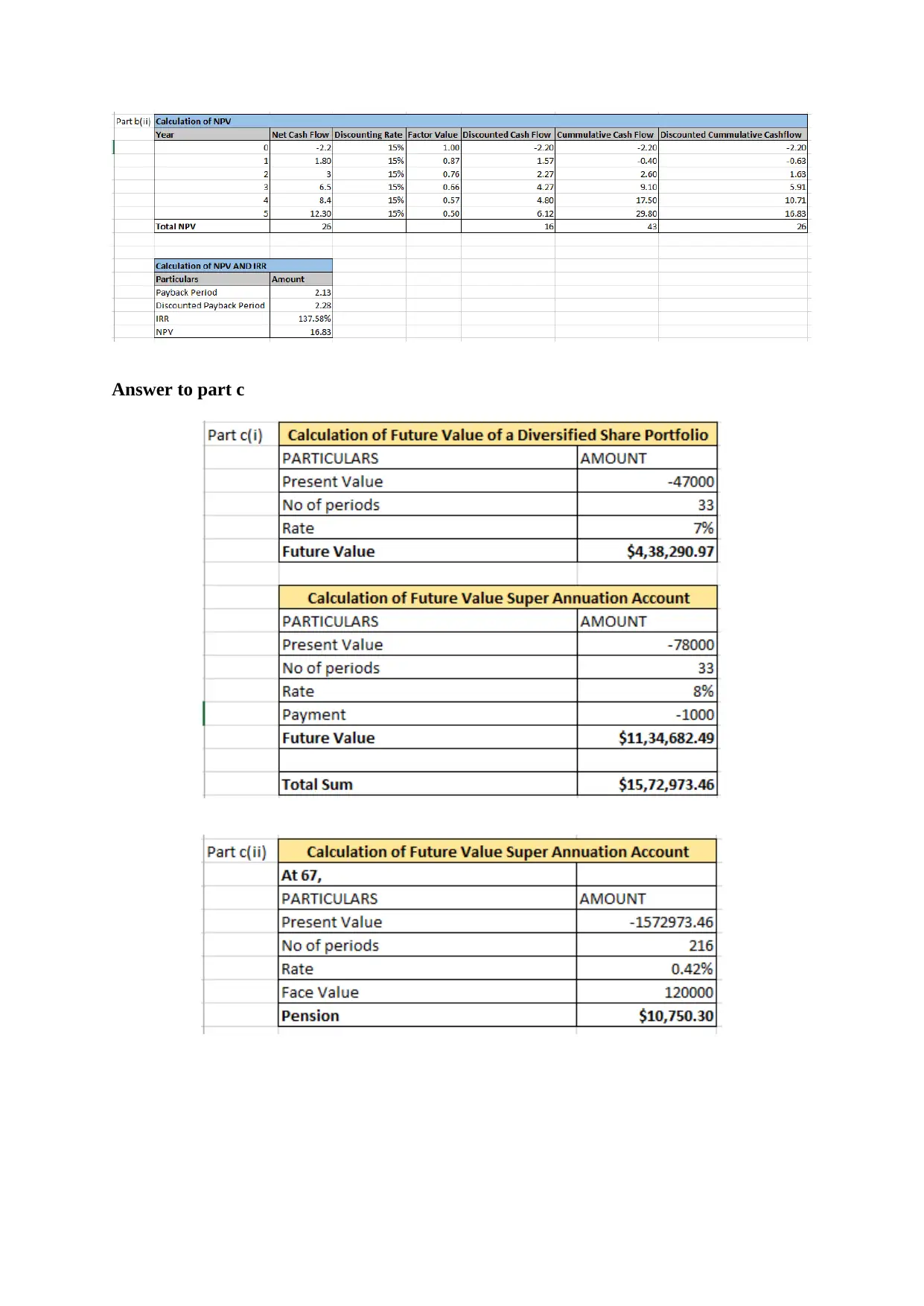
Answer to part c
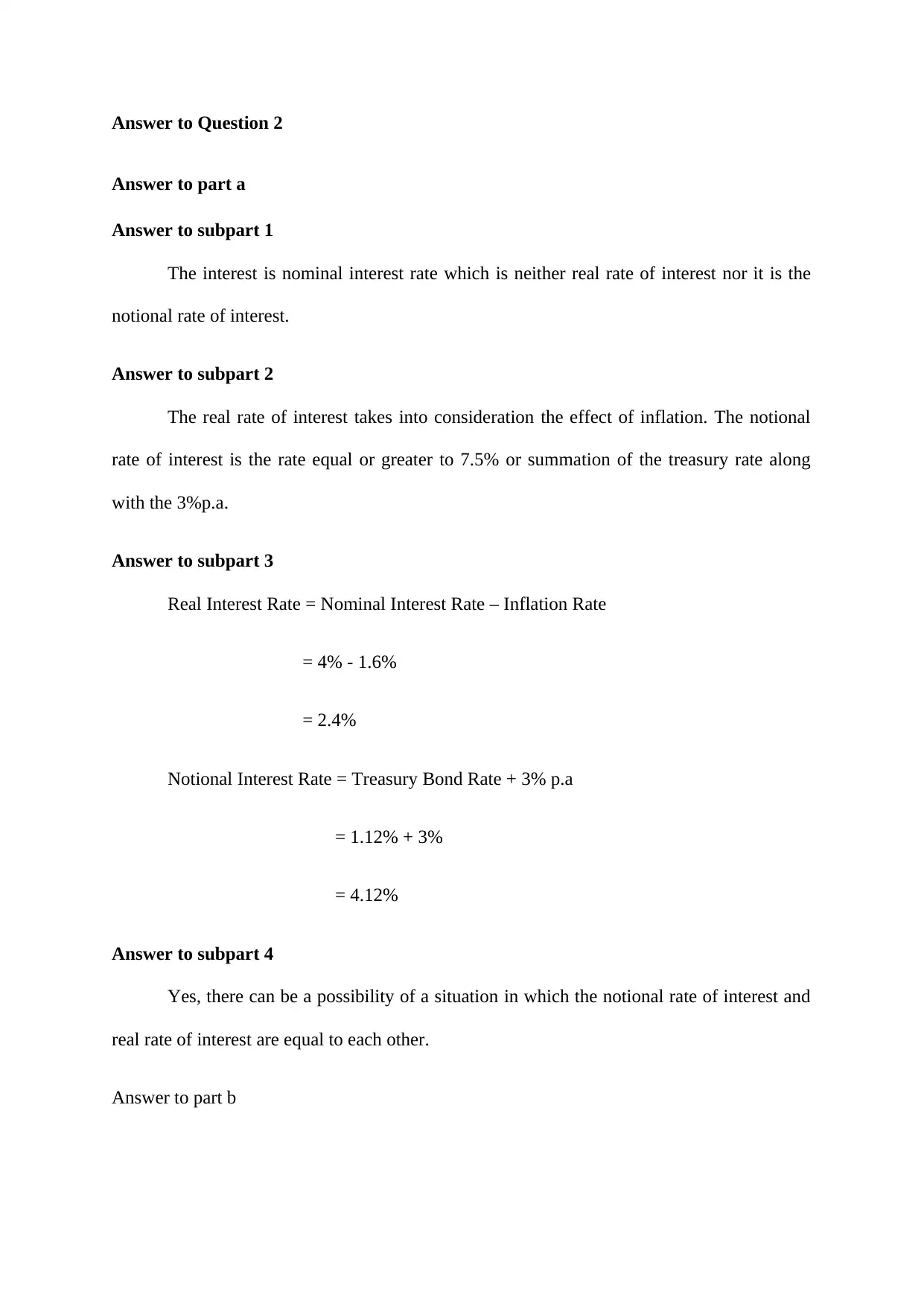
Answer to Question 2
Answer to part a
Answer to subpart 1
The interest is nominal interest rate which is neither real rate of interest nor it is the
notional rate of interest.
Answer to subpart 2
The real rate of interest takes into consideration the effect of inflation. The notional
rate of interest is the rate equal or greater to 7.5% or summation of the treasury rate along
with the 3%p.a.
Answer to subpart 3
Real Interest Rate = Nominal Interest Rate – Inflation Rate
= 4% - 1.6%
= 2.4%
Notional Interest Rate = Treasury Bond Rate + 3% p.a
= 1.12% + 3%
= 4.12%
Answer to subpart 4
Yes, there can be a possibility of a situation in which the notional rate of interest and
real rate of interest are equal to each other.
Answer to part b
Answer to part a
Answer to subpart 1
The interest is nominal interest rate which is neither real rate of interest nor it is the
notional rate of interest.
Answer to subpart 2
The real rate of interest takes into consideration the effect of inflation. The notional
rate of interest is the rate equal or greater to 7.5% or summation of the treasury rate along
with the 3%p.a.
Answer to subpart 3
Real Interest Rate = Nominal Interest Rate – Inflation Rate
= 4% - 1.6%
= 2.4%
Notional Interest Rate = Treasury Bond Rate + 3% p.a
= 1.12% + 3%
= 4.12%
Answer to subpart 4
Yes, there can be a possibility of a situation in which the notional rate of interest and
real rate of interest are equal to each other.
Answer to part b
⊘ This is a preview!⊘
Do you want full access?
Subscribe today to unlock all pages.

Trusted by 1+ million students worldwide
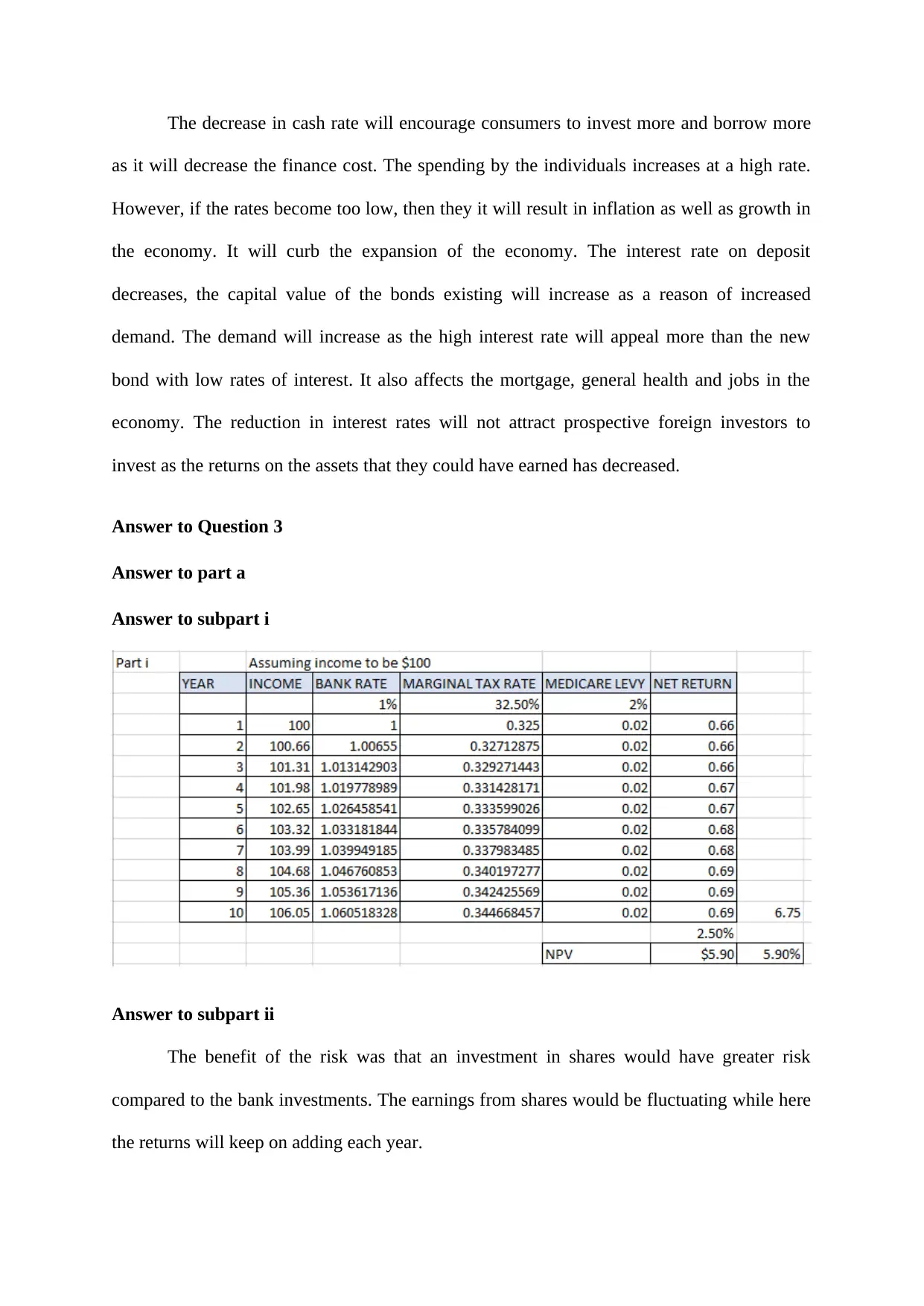
The decrease in cash rate will encourage consumers to invest more and borrow more
as it will decrease the finance cost. The spending by the individuals increases at a high rate.
However, if the rates become too low, then they it will result in inflation as well as growth in
the economy. It will curb the expansion of the economy. The interest rate on deposit
decreases, the capital value of the bonds existing will increase as a reason of increased
demand. The demand will increase as the high interest rate will appeal more than the new
bond with low rates of interest. It also affects the mortgage, general health and jobs in the
economy. The reduction in interest rates will not attract prospective foreign investors to
invest as the returns on the assets that they could have earned has decreased.
Answer to Question 3
Answer to part a
Answer to subpart i
Answer to subpart ii
The benefit of the risk was that an investment in shares would have greater risk
compared to the bank investments. The earnings from shares would be fluctuating while here
the returns will keep on adding each year.
as it will decrease the finance cost. The spending by the individuals increases at a high rate.
However, if the rates become too low, then they it will result in inflation as well as growth in
the economy. It will curb the expansion of the economy. The interest rate on deposit
decreases, the capital value of the bonds existing will increase as a reason of increased
demand. The demand will increase as the high interest rate will appeal more than the new
bond with low rates of interest. It also affects the mortgage, general health and jobs in the
economy. The reduction in interest rates will not attract prospective foreign investors to
invest as the returns on the assets that they could have earned has decreased.
Answer to Question 3
Answer to part a
Answer to subpart i
Answer to subpart ii
The benefit of the risk was that an investment in shares would have greater risk
compared to the bank investments. The earnings from shares would be fluctuating while here
the returns will keep on adding each year.
Paraphrase This Document
Need a fresh take? Get an instant paraphrase of this document with our AI Paraphraser
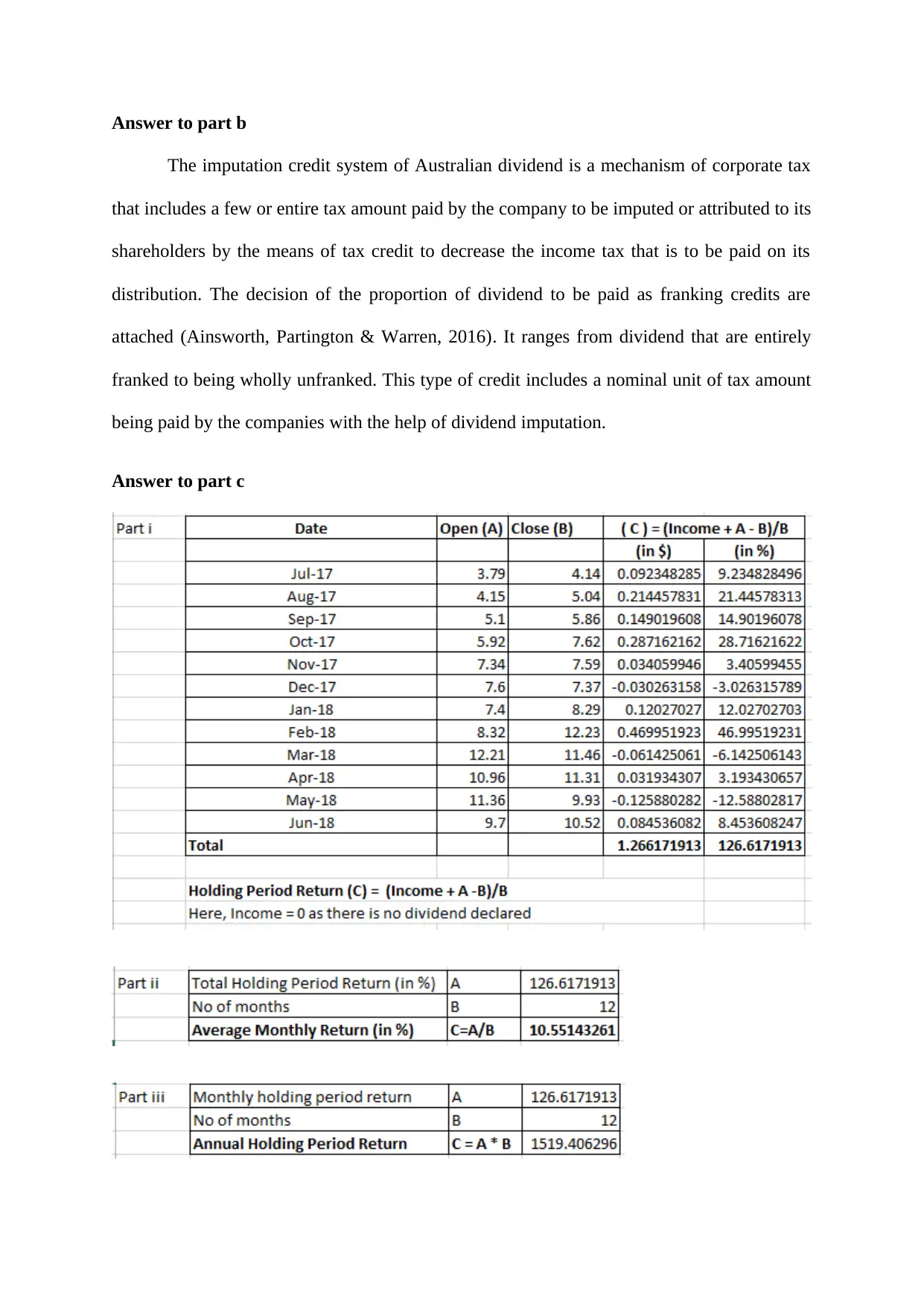
Answer to part b
The imputation credit system of Australian dividend is a mechanism of corporate tax
that includes a few or entire tax amount paid by the company to be imputed or attributed to its
shareholders by the means of tax credit to decrease the income tax that is to be paid on its
distribution. The decision of the proportion of dividend to be paid as franking credits are
attached (Ainsworth, Partington & Warren, 2016). It ranges from dividend that are entirely
franked to being wholly unfranked. This type of credit includes a nominal unit of tax amount
being paid by the companies with the help of dividend imputation.
Answer to part c
The imputation credit system of Australian dividend is a mechanism of corporate tax
that includes a few or entire tax amount paid by the company to be imputed or attributed to its
shareholders by the means of tax credit to decrease the income tax that is to be paid on its
distribution. The decision of the proportion of dividend to be paid as franking credits are
attached (Ainsworth, Partington & Warren, 2016). It ranges from dividend that are entirely
franked to being wholly unfranked. This type of credit includes a nominal unit of tax amount
being paid by the companies with the help of dividend imputation.
Answer to part c
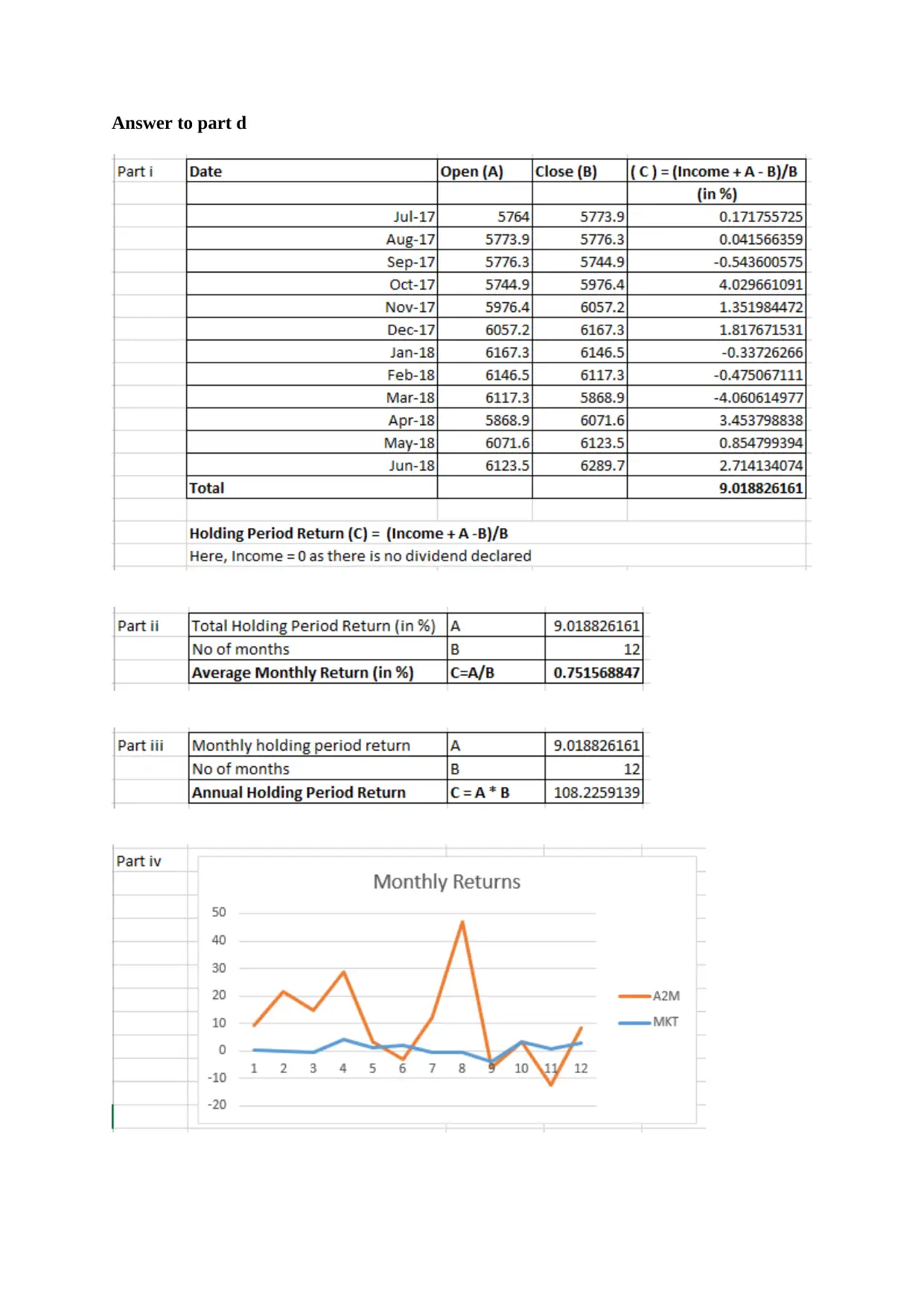
Answer to part d
⊘ This is a preview!⊘
Do you want full access?
Subscribe today to unlock all pages.

Trusted by 1+ million students worldwide
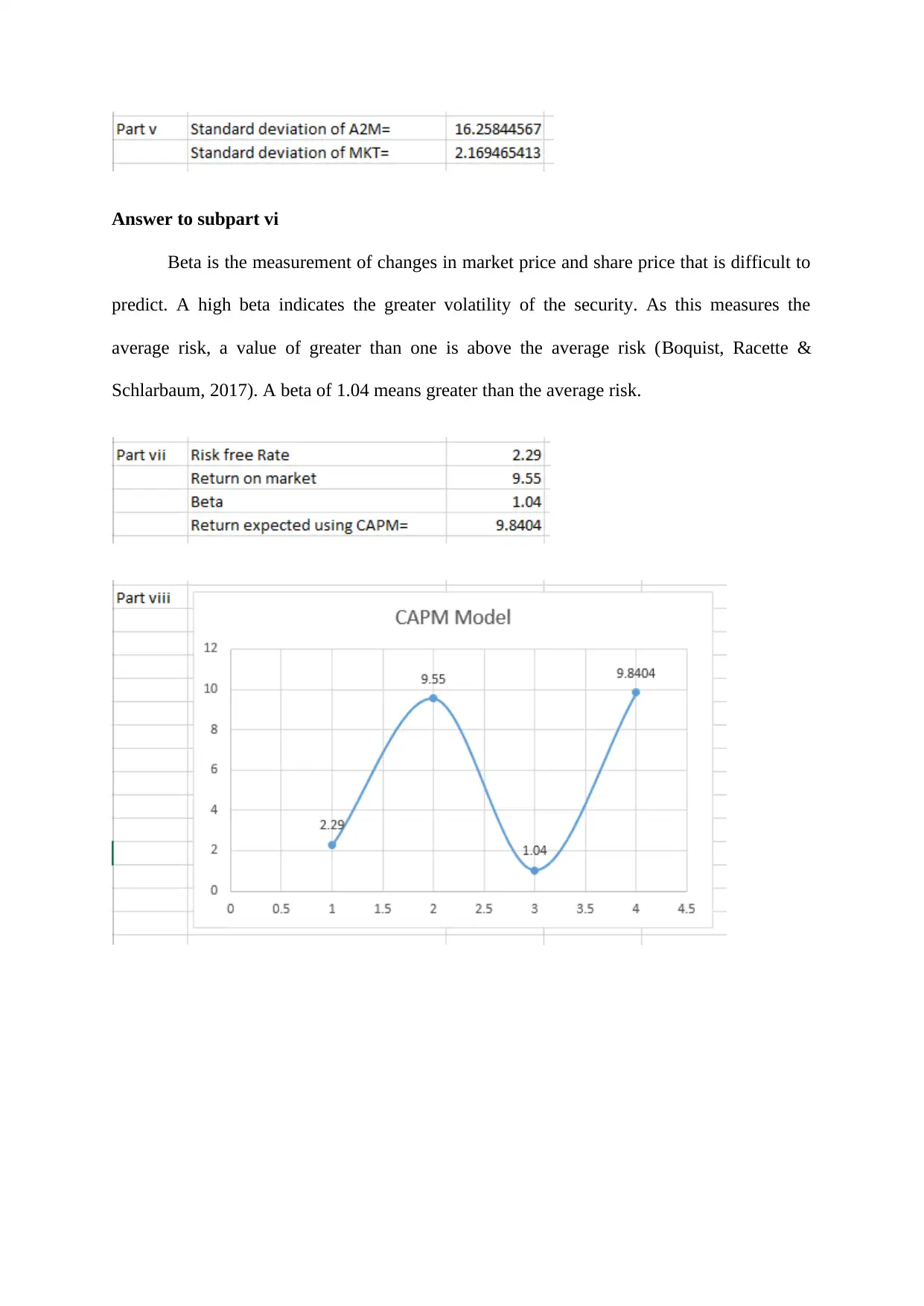
Answer to subpart vi
Beta is the measurement of changes in market price and share price that is difficult to
predict. A high beta indicates the greater volatility of the security. As this measures the
average risk, a value of greater than one is above the average risk (Boquist, Racette &
Schlarbaum, 2017). A beta of 1.04 means greater than the average risk.
Beta is the measurement of changes in market price and share price that is difficult to
predict. A high beta indicates the greater volatility of the security. As this measures the
average risk, a value of greater than one is above the average risk (Boquist, Racette &
Schlarbaum, 2017). A beta of 1.04 means greater than the average risk.
1 out of 10
Related Documents
Your All-in-One AI-Powered Toolkit for Academic Success.
+13062052269
info@desklib.com
Available 24*7 on WhatsApp / Email
![[object Object]](/_next/static/media/star-bottom.7253800d.svg)
Unlock your academic potential
Copyright © 2020–2025 A2Z Services. All Rights Reserved. Developed and managed by ZUCOL.





